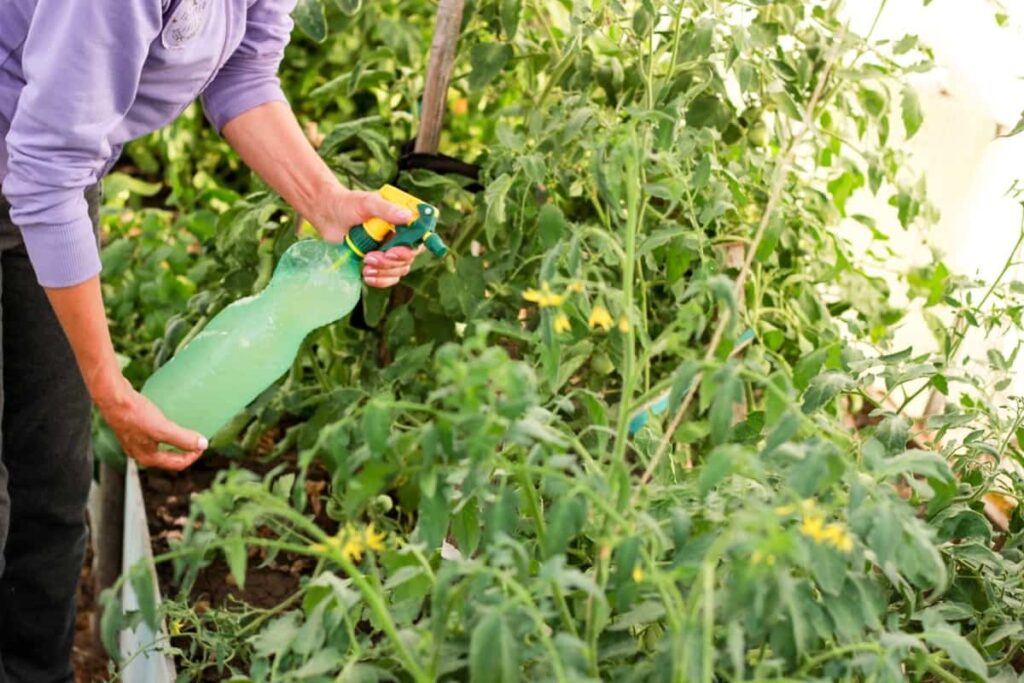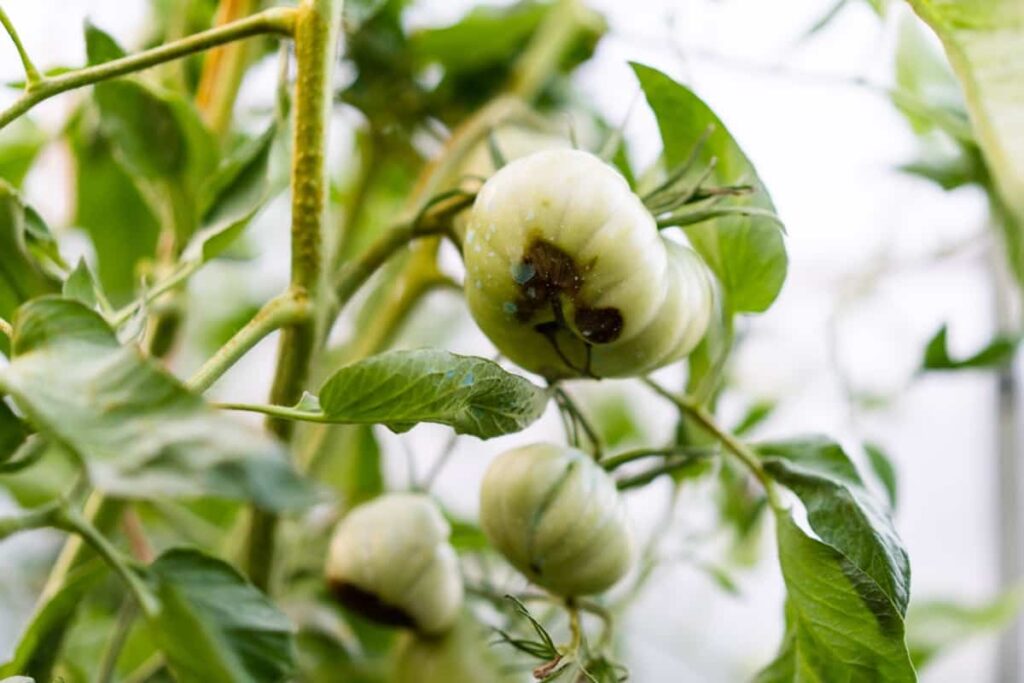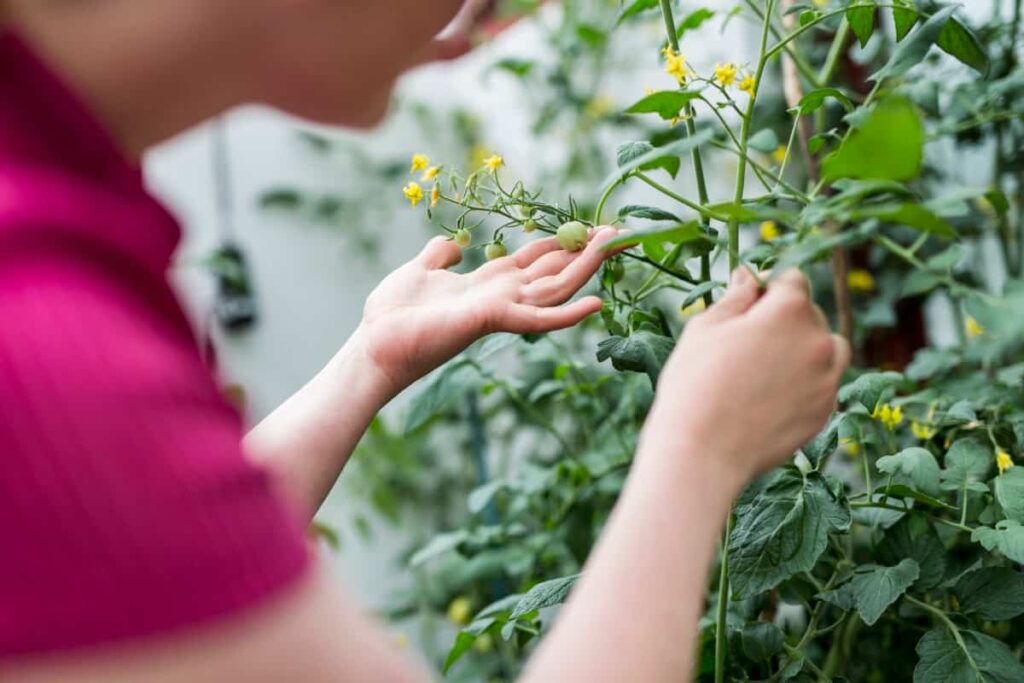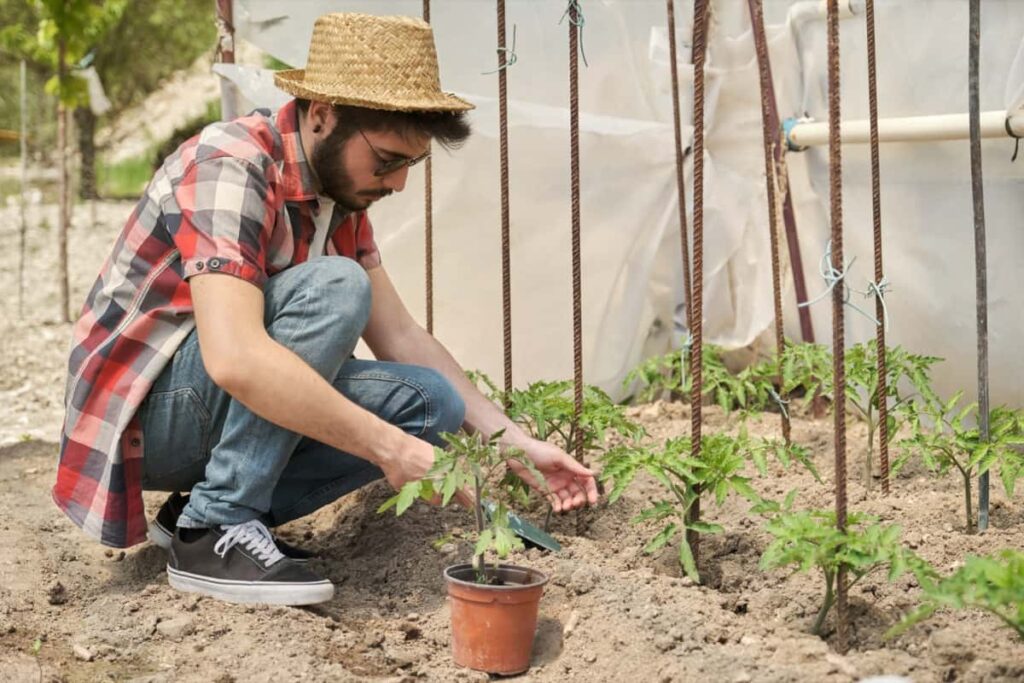Tomatoes are a beloved staple in many gardens but can be susceptible to various pests and diseases. However, by taking proactive measures and adopting organic pest and disease control methods, you can ensure the health and vitality of your tomato plants.

This blog will explore the common pest and diseases that affect tomatoes, their symptoms, and effective treatment options. We will cover everything from tomato blight and aphids to fruit worms and whiteflies. You will also discover natural remedies, companion planting techniques, and the use of beneficial insects to prevent and manage tomato pests and diseases.
Common Tomato Pests and Diseases
Common Tomato Plant Diseases
- Septoria Leaf Spot: This fungal disease causes circular grayish-white patches with dark edges on tomato leaves, leading to yellowing, withering, and leaf drop.
- Anthracnose: Characterized by small, circular indented areas on tomato fruits, this fungus causes rotting, especially in overripe tomatoes.
- Fusarium and Verticillium Wilt: These wilt diseases, caused by fungi in the soil, result in wilting, yellowing, and eventual death of the plant due to disrupted water movement.
- Early Blight (Alternaria): Lower leaves develop brown or black spots with dark edges, while fruits may exhibit sunken black areas with concentric rings.
- Late Blight: This fast-spreading fungal disease manifests as green-black splotches on leaves, leading to rotten, irregular-shaped brown blotches on fruits.
- Mosaic Virus: This viral infection causes light green and yellow mosaic-like markings on leaves and mottling on fruits, reducing fruit quantity and quality.
- Blossom Drop: Temperature extremes, either above 85°F or below 58°F, can result in the drop of developing tomato blossoms.
- Blossom–End Rot: Calcium deficiency due to fluctuating water availability leads to a sunken, dead area on the blossom-end of the fruit.
- Damping Off: A frustrating fungal disease, it causes seedling collapse or failure to germinate, and it can be prevented by proper seed treatment and soil management.
- Sunscald: Overexposure to sunlight causes a section of the fruit to become soft, light in color, and dry.
In case you missed it: Nutritional Deficiencies in Tomato Crop: How to Fix, Solutions, and Treatment

Common Tomato Plant Pests
- Aphids: These sap-sucking insects can be found on the stems and foliage of tomato plants. They can be controlled using Neem oil, insecticidal soaps, or spraying them with a hard stream of water.
- Blister Beetles: Blister beetles can damage tomato plants and can also be harmful to humans. They can be picked by hand and placed in a jar of soapy water.
- Colorado Potato Beetle: These beetles are widespread and can damage tomato plants by eating the leaves. Handpicking them and using trap plants like potatoes can help control their population.
- Cutworms: Cutworms are moth caterpillars that can destroy tomato plants by attacking the stems. Collars around the stem and removing them by hand can prevent damage.
- Flea Beetles: These small beetles can cause damage to tomato plants by making them unhealthy. Dusting diatomaceous earth or using sticky traps can help control them.
- Hornworms: Hornworms are large caterpillars that can defoliate tomato plants. They can be picked by hand and destroyed. Companion plants like dill, basil, and marigolds may help repel them.
- Leafhoppers: Leafhoppers can suck sap from tomato plants and transmit diseases. Controlling them can be done using a strong stream of water or row covers.
- Leaf Miners: Leaf miners are small flies whose larvae eat through tomato leaves. Removing infested leaves and introducing natural predators can help control them.
- Potato Aphids: Potato aphids attack tomato and potato plants, causing leaves to curl and fruit deformities. Spraying them off with water and attracting predatory insects can help control their population.
- Psyllids: Psyllids are small insects that overwinter in warm climates. They can cause leaf yellowing and are difficult to control. Predatory insects and sticky paper can help reduce their numbers.
- Root-Knot Nematodes: These tiny worms attack the roots of tomato plants, causing poor growth. Sanitation and planting marigolds can help prevent infestations.
- Slugs and Snails: These pests can damage tomato plants, and population control is key. Handpicking, creating beer traps, and attracting natural predators can help manage their numbers.
- Spider Mites: Spider mites infest tomato plants, leaving webbing on the leaves and stems. Spraying with cold water or using insecticidal soap can help control them.
- Thrips: Thrips feed on tomato plant juices. Tomato leaves stem, and these small insects can damage fruits. Thrips prefer fragile plants. Insecticidal soaps, horticultural oils, ladybugs, and lacewings help control thrips.
- Tomato Fruitworm: Tomato fruitworms, often called corn earworms or cotton bollworms, are common pests that eat tomato fruits. They tunnel through fruits, making them unmarketable. Handpick larvae or apply insecticides to control tomato fruit worms.
- Whiteflies: Tomato plants often get whiteflies attacked. They feed on plant sap on leaf undersides, producing wilting, yellowing, and stunted growth. Whiteflies spread plant diseases. Yellow sticky traps, insecticidal soaps, neem oil, ladybugs, and parasitic wasps can control whiteflies.
- Wireworms: Wireworms, click beetle larvae, can damage tomato plants. Slender, reddish-brown worms eat plant roots, stems, and fruits. Bait traps, soil nematodes, and crop rotation can lower wireworm populations.
- Worms Cutworms, armyworms, and loopers can damage tomatoes. These caterpillars can damage plant leaves and stem. Handpicking and spraying caterpillar pesticides can control worm infestations.
In case you missed it: How to Grow Tomatoes in Australia from Seed: Best Time to Plant in Pots, the Backyard at Home for Sydney, Melbourne, and Victoria

Natural Remedies for Tomato Pests and Diseases
Natural remedies can be easy to manage garden tomato pests and diseases. Experts suggest that using neem oil, derived from the neem tree, can help control aphids, whiteflies, and mites on tomato plants. Neem oil disrupts the insects’ feeding and reproductive abilities, reducing their population.
Another natural remedy is the application of insecticidal soap, which can be made from potassium salts and fatty acids. Insecticidal soap suffocates soft-bodied pests such as aphids, spider mites, and thrips. Garlic extract, when sprayed on tomato plants, has shown potential in repelling chewing insects like caterpillars and beetles due to its strong odor.
Incorporating beneficial insects like ladybugs and lacewings can help control pests by preying on them. Planting marigolds around tomato plants has been found to repel nematodes, while companion planting with basil can deter tomato hornworms. Natural remedies may require repeated applications and should be used with other integrated pest management strategies for optimal results.
Tomato Plant Diseases Symptoms and Treatments
- Early blight in Tomato Plants manifests as dark spots with rings on lower leaves. Pruning infected leaves and using fungicides are recommended treatments.
- Fusarium wilt causes the entire plant to wilt during the day, with leaves turning yellow on one side. Planting resistant tomato varieties is an effective approach.
- Powdery mildew appears as light green or yellow spots on leaves, which eventually turn dusty white. Treatment options include sulfur dust, fungicides, bio fungicides, and horticultural oil.
- Anthracnose is characterized by small, sunken, water-soaked spots on ripening fruit. The use of preventive fungicides is crucial. Septoria leaf spots are present as small, brown, round spots on leaves. Fungicides and bio fungicides are effective treatments.
- Botrytis displays gray-brown mold on leaves, stems, or fruit. Specific fungicides and bio fungicides targeting gray mold are recommended.
- Bacterial speck causes irregular brown or black spots near leaf margins, on stems, or on fruit. Copper fungicides used preventively can be effective.
- Southern blight results in stem lesions at or near the soil line. Treatments include solarization, fungicides, bio fungicides, and soil fumigants.
Identifying and Controlling Tomato Leaf Diseases
Tomato Leaf diseases can be identified through symptoms such as spots, discoloration, and lesions on the leaves. Effective control measures include proper sanitation, such as removing and destroying infected leaves and practicing crop rotation to reduce disease buildup in the soil. Using disease-resistant tomato varieties and providing adequate airflow and sunlight can also help prevent leaf diseases. Fungicides and bio fungicides can be applied as preventive or curative treatments, following the instructions and recommendations provided by experts.
Organic Treatment Methods for Tomato Plant Diseases
Neem oil, derived from the neem tree, has antifungal properties and can combat powdery mildew and other fungal infections. Compost tea, made from composted organic matter, enhances the plant’s natural defenses against diseases.
In case you missed it: Roma Tomato Growing Guide: For Pots, Ground, Raised Beds, and Buckets

Applying a mixture of baking soda and water can help control fungal infections like septoria leaf spots. Additionally, introducing beneficial insects, such as ladybugs and predatory mites, can aid in managing pest populations in an organic manner. Copper-based fungicides can control various diseases, including early blight and bacterial speck.
Effective Methods for Preventing Tomato Blight
To effectively prevent tomato blight, it is important to identify and distinguish between the different types of blight: early blight, Septoria blight, and late blight. Fungi cause early and Septoria blight, while late blight is a water mold. Symptoms include spots on the leaves, and each type of blight has unique characteristics. Prevention is key, and you can start by planning your garden layout to avoid planting tomatoes near other nightshade crops.
Growing resistant varieties and staking your plants for proper airflow are also recommended. Fertilizing and watering at ground level, removing weeds, applying mulch, and practicing crop rotation can help prevent infection. If blight does occur, removing infected plants and using fungicides, such as copper-based or synthetic options, can be effective. Biofungicides containing Bacillus subtilis can also help control early blight.
Tomato Hornworm Control Methods
Tomato hornworms (Manduca quinquemaculata) are destructive pests that threaten tomato, potato, pepper, eggplant, and tobacco plants. They consume leaves, stems, and fruit, making them difficult to spot due to their protective coloring. Damage from hornworms is typically observed in midsummer and continues throughout the growing season.
To identify tomato hornworms, look for green caterpillars measuring 3-4 inches long, with seven diagonal white stripes and a black or red horn. Handpicking is an effective control method, and beneficial insects like lacewings and ladybugs can be introduced. Natural pesticides, such as Bacillus thuringiensis (Bt) and Diatomaceous Earth, are also useful in controlling these pests.
Preventing Fungal Diseases in Tomato Plants
Preventing fungal diseases in tomato plants is crucial for a successful harvest. Common fungal diseases like Verticillium wilt, Fusarium wilt, and Alternaria (early blight) can impact tomato plants. Alternaria causes bullseye leaf spots and lesions on fruits, while Fusarium wilt and Verticillium wilt result in leaf wilting and yellowing.
To prevent these diseases, avoid handling wet tomatoes, use drip irrigation to limit moisture on leaves, maintain good airflow through pruning and trellising, rotate crops every four years, improve soil health with testing, amendments, and organic practices, and consider disease-resistant varieties or organic fungicides if necessary. Following these tips can help keep your tomato plants disease-free harvest.
Controlling Tomato Fruit Worm Infestations
Tomato fruit worms (Helicoverpa zea) are moth larvae that are cream, yellow, green, or brown. North America, except Alaska and northern Canada, is their home. Fruitworms are night-active Noctuidae moths. The cream or white larvae eat tomatoes, peppers, maize, melons, peas, potatoes, and pumpkins after hatching from eggs on tomato plants. Fruitworm tunnels leave frass (caterpillar feces) and destroy the fruit.
In case you missed it: High Yield Hybrid Tomato Varieties in India: For Winter, Summer, and Rainy Season

They may migrate 250 miles overnight. Tomato fruit worms are 1.5 to 2 inches long and hairy. They lack horns and are smaller than tomato hornworms. Tomato fruit worms have four stages: adult moth, egg, larva (caterpillar), and pupa. Adult moths lay cream-colored or pure white eggs on tomato leaves, which darken before the larvae hatch. Larvae, which feed on tomatoes, are the most harmful.
They emerge as moths from lustrous brown cocoons. Sanitation (removing damaged fruit and debris), parasitic wasp release, diatomaceous earth, and Bt help manage tomato fruitworm infestations. Conservation biocontrol (attracting beneficial predators), crop rotation, crop reduction, and row coverings or fine insect netting for tomato plants are preventative strategies.
Organic Solutions for Tomato Whitefly Infestations
- Organic Neem Oil: Neem tree seeds are used to make organic pesticides. It kills plant-feeding insects without harming birds, mammals, bees, or plants. Avoid using it in aquaponics since fish can be poisoned.
- Lacewing Insects: You can buy predatory lacewings for your garden. They control whiteflies and aphids by eating them.
- DIY White Fly Spray: Water, vegetable oil, and dishwashing liquid make a white fly spray. Spray them on flies. This spray paralyzes insects, killing them. Avoid using it on hot days to protect plants. Yellow sticky fly paper can catch whiteflies near tomato plants. It reduces their population but may trap helpful insects.
Tomato Plant Virus Diseases Prevention Strategies
- Tomato plants can be severely affected by viral diseases, leading to reduced yield and fruit quality. Three common viral diseases encountered in home gardens are Cucumber Mosaic Virus (CMV), Tobacco Mosaic Virus (TMV), and Tomato Spotted Wilt Virus (TSWV).
- Stunted growth, leaf yellowing, mottling, and stem wrinkling give tomatoes a “shoestring” appearance.
- Tobacco and tomato mosaic viruses induce leaf mottling, curling, and deformity. Infected plants may stunt, ripen unevenly, and set fewer fruits.
- Tomato Spotted Wilt Virus causes leaf bronzing, streaking, and mottled young fruit in many plant species. Unmarketable mature fruit has white or yellow spots.
- Viruses cannot be treated, so prevention is essential. To minimize seed-transmitted viruses, clean seeds from reliable sources, heat dry seeds, or treat seeds with 10% Trisodium Phosphate. Choose virus-resistant tomato varietals. Remove diseased plants immediately. Control White fly Insects as it is a vectors for Virus disease.
Tomato Plant Bacterial Diseases Prevention and Treatment
- Bacterial cankers can be seed-borne and survive in solanaceous weeds and decaying plant tissue.
- Symptoms of bacterial canker can vary in the field and high tunnels, making diagnosis challenging; spots on leaves, wilting, discoloration, brown streaks, stem cankers, and fruit spots.
- Bacterial canker is caused by Clavibacter michiganensis. Warm temperatures and high moisture encourage its development.
- To manage bacterial canker, practice cultural controls such as planting in disease-free areas, using certified pathogen-free seeds, avoiding infected plants, keeping leaves dry, spacing plants for airflow, and removing or burying infected plants.
- For farms, monitor plants regularly, use pathogen-free seed, disinfect tools and equipment, clean pruning tools, discard infected materials, avoid working with wet foliage, promptly remove infected plants, and practice crop rotation.
- Chemical control options for bacterial canker are limited, and preventive sprays during transplant production are more effective than post-transplant or field sprays.
In case you missed it: Vertical Tomato Farming: Modern Way of Getting More Yields in Less Space

Integrated Pest Management for Tomato Crops
- IPM reduces pesticide use and promotes sustainable tomato pest management.
- It involves pest population monitoring, action thresholds, preventive measures, and biological, cultural, and chemical control strategies.
- Ladybugs and parasitic wasps prey on pest insects in biological control.
- Proper irrigation, fertilizer, and crop rotation lessen pest susceptibility.
- Chemical control is a last option that uses pesticides only when needed and according to criteria.
- Monitoring pests and benefits is vital for prompt intervention and decision-making.
- IPM minimizes pesticide resistance, protects non-target species, and sustains tomato output.
Companion Planting to Control Tomato Pests
Companion planting for tomato pest control involves strategically growing plants like marigolds, basil, nasturtiums, borage, chives, garlic, parsley, and mint alongside tomatoes. These companion plants repel or attract beneficial insects that prey on pests like aphids, nematodes, flies, mosquitoes, thrips, and Japanese beetles. By avoiding planting tomatoes near susceptible crops and implementing companion planting, a balanced ecosystem can be created, reducing the reliance on chemical pesticides.
Natural Predators for Tomato Pests
Ladybugs, lacewings, parasitic wasps, ground beetles, minute pirate bugs, praying mantises, birds, nematodes, and spiders are natural predators that help control tomato pests such as aphids, caterpillars, and mites. To attract and support these predators, diversify plantings, avoid broad-spectrum pesticides, and create habitats with flowering plants and shrubs.
Conclusion
To prevent and manage common tomato pests and diseases, implement cultural practices like crop rotation, proper sanitation, and optimal plant health. Additionally, use integrated pest management strategies, including natural predators, biological controls, and targeted pesticide applications when necessary.
- Budget Friendly Sheep Shed Ideas: Cheap and Low-Cost Tips
- How Much Do Cattle Farmers Make: Revenue Streams in Cattle Farming
- Management Pests and Diseases in Your Cotton Field
- Sheep Farming Business Plan for Beginners
- Aquaponic Farming at Home: A Step-By-Step Guide
- Profitable Village Farming Business Ideas in 2024
- High-Yield Aquaculture: Fast-Growing Fish for Farming
- Effective Fish Pond Construction Techniques for Beginners
- Irrigation and Water Management in Pineapple Farming
- Blossom to Harvest: Mastering Flowering and Pollination in Papaya Farming
- Pig Fattening Essentials: From Selection to Sale for Beginners
- Raising Wagyu Cattle: A Complete Guide for Premium Beef Production
- Soil Types and Their Water Holding Capacity
- Optimizing Irrigation Schedules for Coconut Groves for Enhanced Yield
- Espresso Your Garden: Coffee Grounds for Healthier Acid-Loving Plants
- The Best Soil Mix for Snake Plants: How to Mix Your Own Snake Plant Soil
- Green Thumb Success: Expert Tips for Cultivating Greenhouse Beans All Year Round
- Bloom All Year Round: The Ultimate Guide to Indoor Hyacinth Care
- Eco-Friendly Gardening: How to Make Liquid Fertilizer from Kitchen Waste
- Ultimate Guide to Grow Anise in Pots: Explore Seed Propagation to Harvesting
- Guide to Raising Chester White Pigs: Discover Breed Facts to Growth Management
- Mastering the Elegance: The Ultimate Guide to Weeping Cherry Tree Care, Planting, and Maintenance
- Ultimate Guide to Planting Garlic in Grow Bags: Growing Strategies for Beginners
- How to Fix Spider Plant Leaf-Related Problems: Natural and Organic Remedies
- 10 Reasons Why Your Tulsi Plant is Shedding Leaves: Home Remedies and Solutions
- Optimizing Growth and Yield: The Advantages of Palm Bunch Ash Fertilizer
- Utilizing Neem Oil Extract as a Natural Pesticide for Hydrangea
- From Soil to Harvest: Various Ways in Which Farmers Can Use AI Tools
- Steps to Encourage and Induce Citrus Flowers: A Comprehensive Guide
- How to Fix Snake Plant Leaf-Related Issues: Natural and Organic Remedies
- Transform Your Garden into a Fragrant Oasis with Raat Ki Rani (Night Blooming Jasmine)
- Discover the Ideal Chicken Breeds for Philippine Farms
- How to Create a Poultry Egg Farm Business Plan for Profits
- Grow Lemon Cucumbers Like a Pro: Insider Techniques for Bountiful Yields
- Ultimate Guide to Caring for Your Pink Princess Philodendron: Tips for Thriving Variegation
- Areca Nut Profit Per Acre: Calculating Yield and Cost of Cultivation

I am first time farmer and all this information is helping me a lot. Thank you